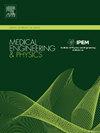一种测量双手运动的瓶式传感器的研制
IF 1.7
4区 医学
Q3 ENGINEERING, BIOMEDICAL
引用次数: 0
摘要
日常生活活动需要双手的协调运动。虽然目前已有单手功能评估设备,但目前定量评估双手运动的设备还存在一定的局限性。这项研究旨在开发和检验一种被称为瓶式传感器的装置的有效性,这种装置可以同时测量双手的运动。将新开发的高精度柔性传感器片包裹在三维打印的瓶盖和身体部位上,制成了瓶型传感器。根据载荷数据计算每个传感器的力分量,并对每个手指的载荷求和。30名健康成年人参与了这项研究,其中21人参与效度研究,9人参与信度研究。在效度研究中,瓶体和瓶盖部分的值与抓握力和夹紧力相关。对于信度研究,比较一天后的结果,计算类内相关系数2、3。发现抓握力和夹紧力与瓶身和瓶盖部分显著正相关。可靠性研究表明,瓶型传感器主体部分的ICC值为0.75。但是,cap部分的ICC为<;0.75,这是不够的。本研究开发的瓶型传感器与握持力和夹紧力有显著的相关性,但瓶盖部分在可靠性方面没有取得令人满意的结果。在未来,瓶型传感器的实用性需要通过改进瓶盖部分,以及在双手运动中评估和在各种疾病患者中测量来明确。本文章由计算机程序翻译,如有差异,请以英文原文为准。
Development of a bottle-type sensor measuring two-hand movement
Daily life activities entail the coordinated movement of both hands. Although devices for evaluating the function of one hand are available, in addition, there are currently some limitations in devices for quantitatively evaluating the two-hand movement. This study aimed to develop and examine the validity of a device, called the bottle-type sensor, which can simultaneously measure two-hand movements.
A bottle-type sensor was created by wrapping a newly developed high-precision flexible sensor sheet around a three-dimensional-printed cap and body part. The force component of each sensor was calculated from the load data, and the loads for each finger were summed. Thirty healthy adults participated in the study, 21 for validity and 9 for reliability. In the validity studies, the values for the body and cap part of the bottle-type sensor were correlated with the grip and pinch forces. For reliability studies, the intraclass correlation coefficient 2, 3 were calculated comparing the results after a day.
Significant positive correlations with the body and cap parts of the bottle-type sensor were found for the grip and pinch forces. Reliability studies revealed that the body part of the bottle-type sensor had an ICC of >0.75. However, the cap part had an ICC of <0.75, which was insufficient.
The bottle-type sensor developed in this study showed significant correlations with the grip and pinch forces, but the cap part did not yield satisfactory results in terms of reliability. In the future, the usefulness of the bottle-type sensor needs to be clarified by improving the cap part, as well as by evaluating it during two-hand movements and measuring it in patients with various diseases.
求助全文
通过发布文献求助,成功后即可免费获取论文全文。
去求助
来源期刊

Medical Engineering & Physics
工程技术-工程:生物医学
CiteScore
4.30
自引率
4.50%
发文量
172
审稿时长
3.0 months
期刊介绍:
Medical Engineering & Physics provides a forum for the publication of the latest developments in biomedical engineering, and reflects the essential multidisciplinary nature of the subject. The journal publishes in-depth critical reviews, scientific papers and technical notes. Our focus encompasses the application of the basic principles of physics and engineering to the development of medical devices and technology, with the ultimate aim of producing improvements in the quality of health care.Topics covered include biomechanics, biomaterials, mechanobiology, rehabilitation engineering, biomedical signal processing and medical device development. Medical Engineering & Physics aims to keep both engineers and clinicians abreast of the latest applications of technology to health care.
 求助内容:
求助内容: 应助结果提醒方式:
应助结果提醒方式:


